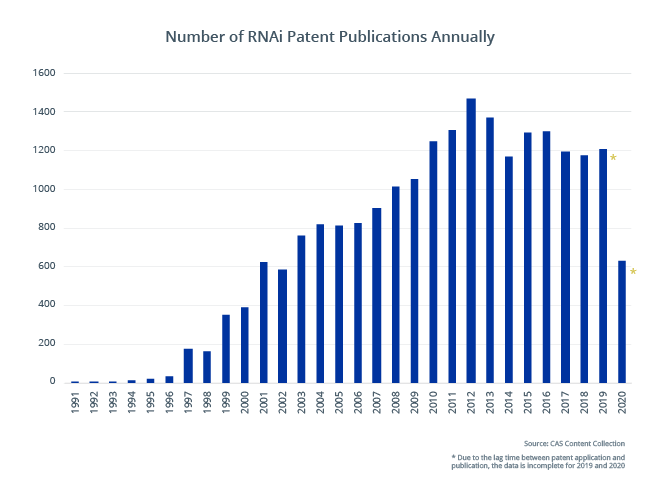Protecting and commercializing the promise of RNAi
The value and complexity of the patent landscape around RNA interference (RNAi) is increasing, creating special challenges for patent searches to protect IP and maximize its value. The US Food and Drug Administration recently approved two siRNA (small interfering RNA) molecule drugs, Onpattro (Patisiran) in 2018 and Givlaari (Givosiran) in 2019, developed by Alnylam Pharmaceuticals. Additionally, 52 siRNA clinical trials spanning multiple therapeutic areas are in progress. Following mechanistic discoveries reported in the 1990s, RNAi has grown to be an important strategy for small-molecule target identification and validation, with more than 12,000 RNAi-related patent publications generated in the last 10 years.

There are two common types of RNAi molecules: micro RNA (miRNA) and small interfering RNA (siRNA). Both are non-coding RNAs, as they do not code for a protein. miRNA are small RNA molecules which silence genes by binding to target messenger RNA (mRNA). Mechanisms include:
- Cleavage of the mRNA strand into two pieces
- Destabilization of the mRNA through shortening of its poly(A) tail
- Less efficient translation of the mRNA into proteins by ribosomes
Andrew Fire and Craig Mello received the Nobel Prize for Physiology or Medicine in 2006 for their discovery of RNAi, also known as post-transcriptional gene silencing (PTGS), opening the door to a brand-new class of drugs that eliminate the root cause of a disease. For example, small interfering RNAs (siRNAs) can selectively silence the expression of a target gene thereby halting or reversing disease progression, rather than slowing it or only treating the symptoms.
As new areas of science emerge, new patenting challenges and questions arise. In addition, prosecuting and managing IP in these new areas requires new search skills. In the case of RNAi, high-quality searches require multiple information sources and often unfamiliar search techniques.
Challenges with searching siRNA include:
- Non-standardized terminology
- Drug delivery that is claimed separately from the molecules
- Limitations of familiar sequence search methodologies
Due to these challenges, patent searches for RNAi-related molecules require specialized expertise in search techniques and information sources where those techniques are implemented to comprehensively find the relevant patent and non-patent literature.
For a full discussion of relevant challenges and search techniques for RNAi, see my recent article published in the May/June issue of The Patent Lawyer Magazine.
Keys to Finding RNAi Art
RNAi is claimed in a variety of ways within patents. siRNA or RNAi terminology is not always used, and chemical modifications can be described a variety of ways. These inconsistencies mean that there is no single search strategy that can be used to efficiently and comprehensively retrieve this information from different data sources.
Because of the inconsistencies of how RNAi-related inventions are claimed and described, a comprehensive search for RNAi art should include both a sequence and text search. There are a variety of human-curated and algorithmically curated databases with information for both sequences and text. A typical workflow for a patent search includes searching sequences with human-curated sequence databases, such as CAS SEQUENCES, and searching algorithmically curated sequence databases. In addition to the sequence searches, text terms should be searched in human-curated databases, such as CAplusSM, and in full-text patent databases.
When developing a search strategy, consider multiple ways the siRNA can be described, such as modified dsRNA, oligonucleotides, oligomers, RNA interference and RNAi. For chemical modifications, the modification pattern, not just a specific sequence, can be claimed and should be searched. Claims can also be target-focused rather than substance-focused, in which case, that aspect may also be searched. To ensure the most reliable results, RNAi searches should cover different features, uses and characteristics of the siRNA/miRNA. CAplus offers the increased power and precision of controlled vocabulary, which help with improving comprehensiveness and managing complexity.
Due to the issues I have highlighted here, RNAi-related searches can be challenging. A high-quality, professional search performed using multiple information sources and search techniques specific to RNAi is critical to support scientific and legal decisions.
Need help with an IP search on RNAi or another emerging technology area? Contact the IP search experts at CAS today.

